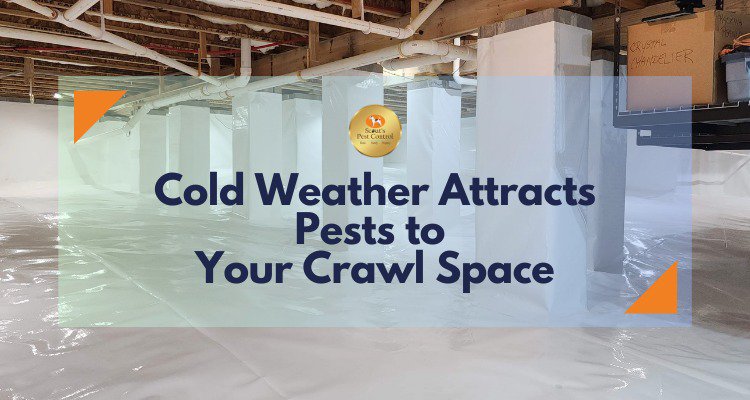A crawl space vapor barrier helps keep moisture from the soil outside your crawl space. This act negates the water that can cause tremendous damage such as crawl space mold, and crawl space mildew. It also offers a conducive environment for wood-damaging pests.
Most homeowners are not your typical home repair enthusiasts and don’t know a lot about home maintenance projects. It’s not a bad thing; after all, that’s why there are a plethora of service professionals to choose from. However, when it comes to your crawl space; choosing the right products and the right company is tantamount to ensuring that you get the best protection for your home. In this article, we’re going to delve into your moisture barrier choice. We will explain why this important facet of your home should be at the forefront of your mind. What type of barrier you should use rather than choosing the cheapest and unsuitable option?
Why Are Thin Crawl Space Vapor Barriers a Problem?

Why does it matter that the other vapor barriers are thinner than 12 mil or 20 mil barriers? Do you really need a thicker crawl space vapor barrier, especially if you’re not planning on visiting your crawl space very often?
These are valid questions. Thin crawl space vapor barriers can cause more trouble than they’re worth for a number of reasons. Those reasons span the gamut of moisture risks, humidity, and of course pests that invade your crawl space.
Tears and Punctures in a thin vapor barrier
This is the biggest problem you’ll likely run into with thin crawl space barriers. Unfortunately, a thin crawl space vapor barrier just isn’t built to withstand almost any type of stress, and it’s likely to tear. These tears can happen via a myriad of causes such as pests, wildlife, and normal degeneration due to the environment.
Furthermore, crawl space barriers don’t just tear because of physical stress. Especially thin barriers, including 6-mil barriers in many cases, may start to erode because of the moisture it’s keeping back. That makes it effectively unusable.
If you want a crawl space vapor barrier that’s going to keep functioning for many years. It’s a prudent move to invest in a high-quality product. Don’t waste money on a less-than-useless vapor barrier. After all, that’s just going to tear, degenerate, and cause further problems in the crawl space and your home.

Building Code Requirements
Building codes are there to keep you safe. by ensuring the building is constructed according to best practices. They’re always updating with more safety protocols. This is in part due to a few missteps that could result in a structure that’s liable to fall down and severely injure anyone who lives inside. Moreover, the building can become prone to changing environmental factors that can cause dangerous structural integrity.
A 6-mil crawl space vapor barrier doesn’t meet building code requirements. Though you’re unlikely to have anyone point that out with a non-commercial home, it’s still a good idea to stick to the building code if you want to stay safe.
Although a 10-mil crawl space vapor barrier may meet building code requirements, you typically don’t just want to meet requirements. If possible, you want to exceed them to create a truly safe structure for your family.
Low-Performance and Low-Efficacy

At the end of the day, a thin crawl space vapor barrier won’t perform at the efficacy of a thicker one. If the barrier suffers even a very small puncture, you’re likely to run into insect problems, seeping moisture, and humidity all over again.
Even if you’re not planning to go into your crawl space any time soon, you can’t guarantee you’ll never need to do so. If you have any issues in your crawl space, you want to make sure the space is dry and safe and allows easy access to a clean area that can be inspected without too much fuss.
It’s just a good idea to opt for high-performance crawl space vapor barriers when you first install them. We will always recommend a 12-mil vapor barrier at a very minimum to get the best results and investment for your home.
Disadvantages of the 6-Mil Barrier
As we mentioned previously, the thinnest barrier is typically a 6-mil barrier. This is the thinnest because barriers any thinner than 6 mils will typically tear extremely easily. Just laying this barrier in the first instance is going to tear within the first application. Furthermore, many contractors use this in order to save money and just cut the corners that should not be cut.
Attempts to save money end up costing more money in the long run. Prior building code requirements permitted the use of 6-mil vapor barrier liners and many individuals installed them in their crawl space to meet the bare minimum. But the bare minimum does not provide the best results.
To give you an idea of what a 6-mil barrier would look like, consider the fact that most plastic grocery bags and some bargain-brand trash bags measure around 3mm at the thickest. Would you want to lay down two grocery or trash bags to protect against crawl space vapor? Probably not.
Advantages of the 12-Mil Barrier
This is one of the most common barrier thicknesses around, and it has been the industry standard for some time. That’s because it’s twice as thick as the very fragile 6-mil barrier and generally affordable, which can make many homeowners feel more comfortable with this thickness of crawl space vapor barrier.
A 12-mil barrier is only very slightly thicker than a 10-mil barrier — to the naked eye, it’s essentially imperceptible. This size of barrier is the one we recommend as a minimum. If you truly want quality and to invest in your home for the long term, talk to us about our crawl space solutions for you. We are recognized as one of the most trusted companies in the business.
The Conclusion
There are many ways to manage moisture in your crawl space. Even after encapsulation, you may need to install a dehumidifier to keep the area completely dry. But keep in mind that if you use a 12-mil barrier your problems will be much less. Book your free crawl space Inspection.





